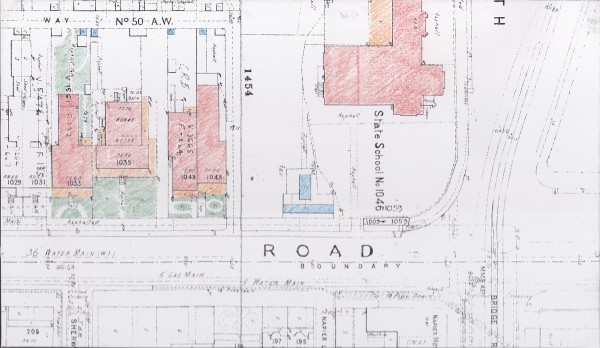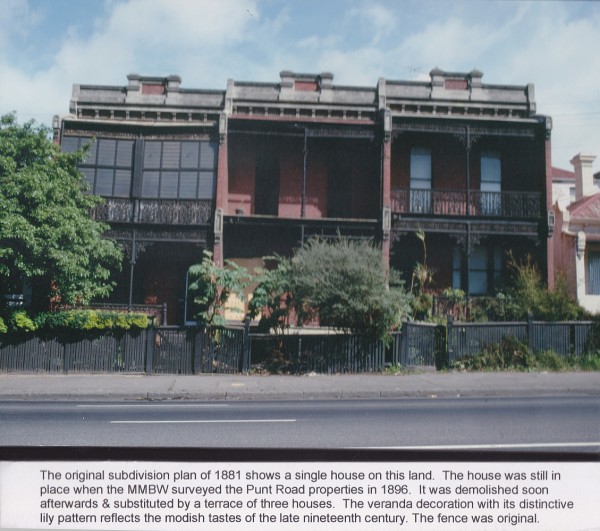East Melbourne, Punt Road 1035, 1037, 1039
- first
- ‹ previous
- 177 of 272
- next ›
- last
Three terrace houses built in a stepped arrangement to accomodate the steep slope of the site.
The first house on this allotment was a remnant of the old Mounted Police Barracks. It and the hospital, which became the Berry Street Babies’ Home, were the only two buildings to remain after all the others were cleared in preparation for the subdivision and sale of the site in 1881.
The barracks dated back to 1838 when it was staffed by men seconded from the military. After separation Victoria formed its own police force and the Richmond Barracks, as it was often known, became one of the most important stations. It was made up of several buildings including barrack-rooms, mess-hall, gaol, stables, riding school and blacksmith.
Inspector Francis Hare was the officer in charge of the barracks from about 1867 until its closure and lived on site with his wife. The Punt Road house might have been his residence. Unfortunately his address is always given simply as Richmond Barracks or Richmond Depot [1]. Francis Hare is remembered as one of the members of the Victoria police force involved in the pursuit and capture of the Kelly Gang.
Another possibility is that the building was the mess-hall. Looking at the 1896 MMBW map it appears to be a very substantial building and would be a very generous house, even for the officer-in-charge. The land frontage, after subdivision, was 56 feet (17 metres) and the house, including its verandahs which ran around three sides, took up the whole width. The description in the rate books varies from a brick house of eight rooms to ten rooms. There appears to be an external staircase leading up to the first floor. This would fit with a newspaper report about a nasty accident which occurred at the barracks. Sergeant James Porter, the long serving and popular drill-instructor, had gone upstairs to find out why the billiard room was in darkness. He returned down the stairs but fell, hitting his head, and later died in the police hospital. The report does not name the building where this happened [2]. At the coronial enquiry the cook stated that ‘he was in the kitchen when he heard a fall, and on going out, found the deceased lying at the bottom of the stairs’ [3]. If it were the mess-hall it would make sense that it had a separate entrance from Punt Road in order that people could attend social events without having to walk through the working part of the complex.
In 1867 Prince Alfred, Duke of Edinburgh visited the Richmond Barracks as part of his royal tour during which, as one newspaper reported, ‘the Prince and his party were conducted to the mess-room, where a first-rate lunch was provided for them and done every justice too [sic]’ [4]. Hopefully one day something will come to light to show conclusively that the Punt Road building was indeed the mess-hall.
When the barracks was dismantled and the land subdivided and put up for auction this block, along with the hospital block, was not auctioned but sold on a prior valuation of £200 [5]. It was bought by the executors in the estate of John Allee, gentleman, who had died in 1877 [6]. The executors were Henry Spink, lapidist, and Charles George Allee, John’s son. Charles Allee bought 46 Berry Street as his own house but the Punt Road house was strictly an investment. The house was known from this time as Laurenny.
The first tenant was Mrs Emily Carslake Bayly, widow of Stanislaus J Bayly, solicitor in the firm of Bayly and Powling of Port Fairy and Warrnambool, who died in 1874. She ran it as a boarding house but stayed little over a year before moving out [7]. Mrs Lena Federici lived there for a short time in 1888 just after her husband Frederick Federici died while performing as Mephistopheles in Gounod’s opera, Faust, at the Princess Theatre [8]. His ghost now famously haunts the theatre. Another tenant was David Dickenson Wheeler, reporter, and later, chief of the ‘Hansard’ staff. He was there for about ten years from 1888 [9]. During Wheeler’s time in the house its name changed to Laurellie.
In 1900 Spink and Allee made the decision to knock down the old house and build three new terrace houses. They commissioned William Pitt, architect, to design them and they were built by John C Duncan of Waltham Street, Richmond [10].
Charles George Allee had died in 1896 and another member of his family must have replaced him as co-executor. Henry Spink died in 1920 and it is only after his death that the property was finally sold and the estate of John Allee wound up. On 23 Feb 1921 the result of the sale was reported as, ‘Three brick balcony houses, each containing seven rooms, land 58 x 143. Nos. 1035, 1037 and 1039 Punt road. East Melbourne, rental £273, £3275’ [11]. The title was split at this time and the houses went to different owners. The houses were eventually demolished as part of the preparations for the widening of Punt Road.
First house:
1881-1882: Mrs Emily Carslake Bayly
1888: Mrs Lena Federici
1888-1898: David Dickenson Wheeler and family
[1] Ancestry: Sands & McDougall PO Directories
[2] The Ballarat Star, 25 Feb 1881, p.3
[3] Weekly Times, 26 Feb 1881, p.7
[4] Illustrated Adelaide Post, 23 Jan 1868, p.3
[5] Argus, 11 May 1881, p.8
[6] Parish map https://emhs.org.au/catalogue/empf0014 and City of Melbourne Rate Books
[7] Ancestry: Sands & McDougall PO Directories
[8] The Age, 27 Mar 1888, p.6
[9] The Herald, 10 May 1888, p.3 and Melbourne Punch, 22 Sep 1898, p.16
[10] Burchett Index, City of Melbourne Notices of Intents to Build: 7 Jun 1900; ref 7939
[11] The Herald, 23 Feb 1921, p.4
- first
- ‹ previous
- 177 of 272
- next ›
- last


